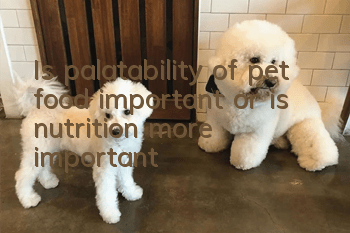Is palatability of pet food important, or is nutrition more important?

According to sales data compiled by a leading pet industry research firm and reported in Petfood Industry magazine: Dogs and cats in the United States apparently prefer chicken-flavored kibble and canned food, at least are the most commonly purchased flavors by their owners.
In the food aisle of your local pet store in the United States, there are dozens of varieties and flavors of canned food that may make you curious about what your pet food tastes like.
With so many varieties on store shelves, how do shoppers decide what to buy? How do pet food companies decide which flavor varieties they will make?
Generally, pet food companies make choices based on meeting nutritional needs, while pet food companies prioritize needs and ingredients, said Mark Brinkmann, vice president of operations at Diamond Pet Foods. “We are always looking at trends in related categories, such as human food, and looking for ways to introduce them into pet food. For example, omega-3 fatty acids, glucosamine and chondroitin, probiotics, grilled or smoked meats are all concepts in human food , we have been able to use it in our pet food.
Nutritional needs come first
Diamond Pet Foods’ animal nutritionists and veterinarians always make nutrition, not taste, their top priority when formulating food for dogs and cats . "Many flavor-enhancing additives (such as digestive or flavoring agents) are used to trick pets into choosing one food over another, which provides limited nutritional value to the formula," says Brinkmann. "They're also expensive, increasing the price pet parents pay for pet food." However, emphasizing nutrition over taste doesn't mean taste (or palatability) doesn't matter. The most nutritious food in the world does no good if your dog or cat doesn't eat it.
Do dogs and cats have a sense of taste?
While humans have 9,000 taste buds, there are approximately 1,700 dogs and 470 cats. This means that dogs and cats have a much weaker sense of taste than we do. That said, dogs and cats do have special taste buds that taste food and even water, but we don't. Dogs have four common taste bud clusters (sweet, sour, salty, and bitter). Cats, by contrast, can't taste sweet foods, but they can taste things we can't, such as adenosine triphosphate (ATP), a compound that provides energy in living cells and marks the presence of meat.
The smell and texture of food, sometimes called "mouthfeel," can also affect dogs and cats' sense of taste. In fact, 70 to 75 percent of our ability to taste something comes from our sense of smell, which is the combination of taste and smell that creates flavor. (You can test this by closing your nose while taking another mouthful of food.a concept. Can you taste food when you close your nose? )
Moving from palatability testing to consumer research
For decades, pet food manufacturers have used two-bowl palatability tests to determine which foods a dog or cat likes. During these tests, pets will be given two bowls of food, each containing a different food. The researchers noted which bowl the dog or cat ate from first, and how much of each food was eaten.
Now more and more pet food companies are shifting from palatability testing to consumer research. In a consumer study, pets were fed one food for two days, followed by a clear-tasting diet for one day, and then another food for two days. Measure and compare the consumption of each food. Brinkmann explains that consumption studies are a more reliable way to measure animal acceptance of food rather than animal preferences. Palatability studies are a grocery store concept used to generate marketing claims. As people increasingly shift Natural foods, most of which don't taste as good as junk foods, so they're not as susceptible to "better taste" as marketing claims.
Pet food palatability has always been an intricate science. Changes in the way Americans view their pets as family members have made pet food manufacturing and marketing more complex. That's why ultimately pet food manufacturers create products that not only appeal to your dogs and cats, but to you too.
- Is it better for Dogo dogs to have their ears erect or cropped? A case of Dogo dog’s ear erection surgery will tell you
- What do dogs eat to protect their stomach? It is important to protect their stomach and treat gastrointestinal diseases in dogs.
- How to tell if your dog is fat? Is your dog overweight?
- Will your dog catch a cold if you blow the air conditioner? What should you do if your dog catches a cold if you blow the air conditioner?
- What should you pay attention to when your dog drinks water? Don’t be careless when it comes to your dog’s drinking water.
- The dog's mouth bites and shakes. Why does the dog's mouth occasionally shake and bite?
- How to cut a dog's hair? Do you know how to cut a dog's hair correctly?
- Can dogs eat raw eggs? Why can’t dogs eat egg whites?
- Common Dog Problems in Summer How to Deal with Different Dog Problems
- How to keep dogs away from skin diseases. If you do this, will you see if your dog will still be infected with skin diseases?



